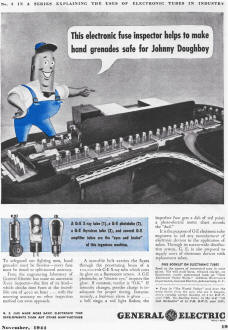General Electric Vacuum Tubes |
||
People have been worrying and complaining about machines and computers taking away jobs from humans ever since Eli Whitney invented the cotton gin (probably even before then). In this advertisement in a 1946 issue of Radio News magazine, General Electric touts the wonders of its electronic inspection apparatus that is capable of inspecting and testing hand grenade fuses at a rate of 4,000 per hour. The job is performed with a variety of specialty vacuum tube types, including an x-ray generator to produce metal-penetrating energy and a phototube to detect the resultant image. A thyratron tube provides 1/10th megavolt pulses to the x-ray tube, and sundry amplifier and rectifier tubes decide whether the image represents a good fuse. Given the criticality of the job, it is doubtful that too many people complained about not having the responsibility of judging the fitness of those hand grenade fuses. General Electric Vacuum Tubes
A G-E X-ray tube (1), a G-E phototube (2), a G-E thyratron tube (3), and several G-E amplifier tubes are the "eyes and brains" of this ingenious machine. To safeguard our fighting men, hand grenades must be flawless - every fuse must be timed to split-second accuracy. From the engineering laboratory of General Electric has come an automatic X-ray inspector - the first of its kind - which checks time fuses at the incredible rate of 4000 an hour ... with the unerring accuracy no other inspection method can even approach. A movable belt carries the fuses through the penetrating beam of a 100,000-volt G-E X-ray tube which casts its glow on a fluorescent screen. A G-E phototube, or "electric eye," inspects the glow. If constant, verdict is "O.K." If intensity changes, powder charge is inadequate for proper timing. Instantaneously, a four-way alarm is given ... a bell rings; a red light flashes; the imperfect fuse gets a dab of red paint; a photo-electric meter chart records the "dud." It is the purpose of G-E electronic tube engineers to aid any manufacturer of electronic devices in the application of tubes. Through its nation-wide distribution system, G. E. is also prepared to supply users of electronic devices with replacement tubes. Free Booklet on Electronic Tubes Send us the names of interested men in your plant. We will mail them, without charge, an illustrated, easily understood book on "How Electronic Tubes Work." Address Electronics Department, General Electric, Schenectady, N. Y. • Tune in "The World Today" and hear the news direct from. the men who see it happen, every evening except Sunday at 6:45 E.W.T. over CBS. On Sunday listen to the G-E "All Girl Orchestra" at 10 P.M. E.W.T. over NBC. G. E. Has Made More Basic Electronic Tube Developments than Any Other Manufacturer! General Electric 162-C-1-8850
Posted October 25, 2019 |
||

